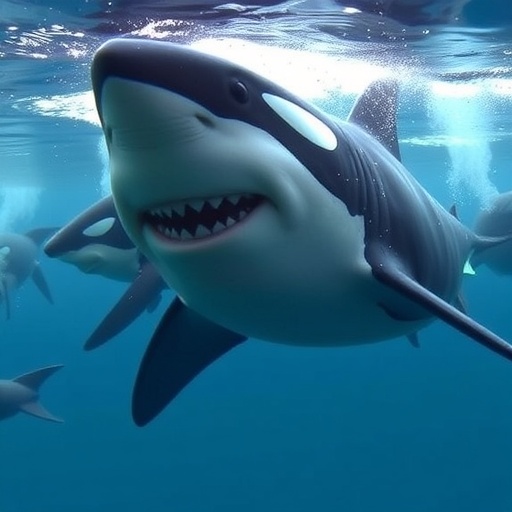In the enigmatic waters of the Gulf of California, a remarkable predator-prey dynamic has come to light, challenging our understanding of marine food webs. Recent observations have documented a specialized pod of killer whales, known as Moctezuma’s pod, skillfully hunting juvenile great white sharks (Carcharodon carcharias). This unprecedented interaction exposes a new facet of orca hunting behavior, highlighting their cognitive sophistication and adaptive hunting strategies.
The intricate hunting process employed by these orcas involves a behavior that is both deliberate and strategic. Photographic evidence shows the orcas expertly flipping young white sharks upside down, inducing tonic immobility—a temporary state of paralysis that significantly diminishes the shark’s ability to defend itself. This state, a well-documented physiological response in sharks, is instrumental for the orcas to access the nutrient-dense liver, a prized organ rich in lipids and essential vitamins that offer a high-energy food source.
During two separate documented incidents in August 2020 and August 2022, researchers witnessed five individuals from Moctezuma’s pod collaboratively targeting juvenile white sharks. These hunts were characterized by the orcas herding their prey to the surface, executing the inversion tactic, and subsequently consuming the liver while likely leaving the rest of the carcass behind. Such precision suggests an evolved hunting culture within the pod, where knowledge and techniques are transferred across generations, underscoring the social complexity of these cetaceans.
This behavior not only reveals orcas’ advanced cognitive abilities but also provides insight into the plasticity of predator-prey interactions under shifting environmental conditions. Juvenile white sharks, which lack the experiential learning of adult conspecifics, appear vulnerable to these tactics, potentially due to naivety regarding orca predation threats. Adult white sharks reportedly respond to orca presence with avoidance behavior, vacating their seasonal aggregation sites for extended periods, indicating an innate or learned fear response that juveniles may not yet possess.
Moctezuma’s pod itself is no stranger to elasmobranch hunting. Previously observed preying on rays as well as whale and bull sharks, this pod’s diverse dietary habits suggest an ability to exploit various marine species depending on availability. The newly recorded interaction with juvenile great whites enhances the understanding of this group’s trophic flexibility, positing that environmental factors such as warming ocean temperatures and climatic events might be influencing their foraging behaviors and prey selection.
The Gulf of California has experienced shifts in shark nursery habitats, potentially due to episodic climate phenomena like El Niño, which alter oceanographic conditions. These changes could increase the overlap between juvenile great white sharks and Moctezuma’s pod, offering heightened hunting opportunities for the orcas while adding pressure on juvenile shark populations crucial for species replenishment. The ecological ramifications of this interaction remain to be fully understood and warrant extensive investigation.
Identifying individual orcas through markings on their dorsal fins allowed researchers not only to confirm the members of Moctezuma’s pod but also to track recurring patterns of predation. The data indicate a developing pattern of predation on vulnerable juvenile sharks, with the orcas employing specialized techniques possibly honed through social learning and experience. This finding contributes to a growing body of evidence that orcas display diverse hunting modalities tailored to specific prey types and environmental contexts.
At a mechanistic level, the induction of tonic immobility via inversion is a remarkable example of predator exploitation of prey physiology. Tonic immobility in sharks involves ceasing all voluntary movement, a state believed to be a defense mechanism when caught off guard. The orcas’ ability to reliably trigger this state demonstrates complex understanding and manipulation of prey behavior, minimizing risk of injury from sharp shark teeth during the hunt.
From a broader ecological perspective, these revelations prompt reassessment of killer whale diets and ecosystem roles. The expectation that orcas mainly prey on marine mammals is expanded to include significant predation on elasmobranchs, exposing complex interspecies interactions. This insight is critical for marine conservation strategies, emphasizing the need to consider apex predator dynamics in holistic ecosystem management and protection policies.
Future research aimed at extensive dietary analyses of Moctezuma’s pod is necessary to determine the frequency and dependency on juvenile white sharks within their diet. Such studies face notable challenges due to the high cost of marine fieldwork and the elusive nature of orca hunting events. Nonetheless, advances in remote sensing, drone monitoring, and molecular techniques like environmental DNA (eDNA) analyses may accelerate data acquisition and enrich understanding of these interactions.
Understanding the ecological significance of these interactions extends beyond pure biology—it informs conservation management. Documenting orca predation on juvenile great whites could implicate shifts in white shark population dynamics, potentially affecting prey-predator equilibria and marine biodiversity. Identification of critical habitats for both sharks and orcas could foster targeted protection measures, ensuring the resilience of these species amid escalating anthropogenic pressures.
In conclusion, the novel documentation of Moctezuma’s pod targeting juvenile white sharks in the Gulf of California underscores the nuanced and adaptive predatory behaviors of orcas. It reveals a sophisticated exploitation of prey physiology and a strategic cultural transmission of hunting techniques. These findings highlight the complexity and vulnerability of marine ecosystems responding to environmental variability and reinforce the imperative of integrated research to guide conservation initiatives.
Subject of Research: Animals
Article Title: Novel evidence of interaction between killer whales (Orcinus orca) and juvenile white sharks (Carcharodon carcharias) in the Gulf of California, Mexico
News Publication Date: 3-Nov-2025
Web References: 10.3389/fmars.2025.1667683
Image Credits: Marco Villegas
Keywords: Orcas, Killer whales, Great white sharks, Juvenile sharks, Predator-prey interaction, Tonic immobility, Gulf of California, Marine ecology, Climate change, Elasmobranch predation, Social learning, Marine conservation




